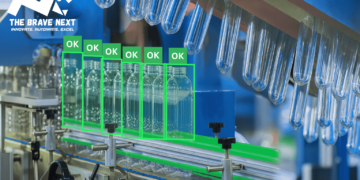The European solenoid valve market is a pivotal segment within the global industrial automation landscape, demonstrating steady growth driven by a confluence of technological advancements, stringent regulatory frameworks, and increasing industrial demand. As a critical component for controlling fluid and gas flow in a multitude of applications, solenoid valves are indispensable across diverse sectors, solidifying their market position
Market Size and Growth Projections:
Europe holds a significant share of the global solenoid valve market, and this dominance is expected to continue. The European solenoid valve market is projected to reach approximately US$2,638.3 million by 2030, growing at a Compound Annual Growth Rate (CAGR) of around 5% from 2024 to 2030. This robust growth reflects the region’s advanced industrial capabilities and its continuous pursuit of enhanced efficiency and automation. Germany, in particular, stands out as a leading market, alongside the UK and France, driven by their strong manufacturing bases and focus on technological innovation.
Key Market Drivers:
Several factors are fueling the expansion of the European solenoid valve market:
- Industrial Automation and Industry 4.0: The widespread adoption of automation across industries like manufacturing, oil & gas, chemical & petrochemical, and pharmaceuticals is a primary driver. Solenoid valves are essential for precise and efficient fluid control in automated processes, minimizing human error and optimizing operational output. The integration of smart sensors and IoT capabilities, aligned with Industry 4.0 initiatives, further enhances the demand for advanced solenoid valves capable of real-time monitoring and predictive maintenance.
- Growing Demand in Key End-Use Industries: Sectors such as food & beverage, water & wastewater treatment, and medical are experiencing significant growth, translating into increased demand for solenoid valves. In food processing, for instance, stainless steel solenoid valves are crucial due to their contaminant resistance and ability to withstand harsh environments. Similarly, the expanding wastewater treatment industries rely heavily on these valves for efficient fluid management.
- Stringent Regulations and Environmental Focus: Europe’s commitment to stringent environmental policies, including directives on emissions and energy efficiency, is a key growth catalyst. Manufacturers are increasingly developing energy-efficient solenoid valves that align with the global push towards greener technologies, such as Burkert’s “Kick & Drop” coils designed to boost energy efficiency. Regulatory compliance in areas like hygiene (e.g., ACS approval in France for potable water applications) also plays a vital role, particularly in the food and medical sectors.
- Technological Advancements: Continuous innovation in solenoid valve technology, including the development of compact designs, miniature valves for precision applications (e.g., in medical devices and analytical instruments), and valves with enhanced durability and performance in harsh environments, is expanding their application scope and driving market growth.
Segmentation Insights:
The European solenoid valve market can be segmented based on various factors:
- By Type: Direct-acting valves currently dominate the market due to their simple working principle and suitability for various applications. Pilot-operating valves also hold a significant share.
- By Function: Two-way solenoid valves, used for simple on/off control, account for a substantial revenue share. However, three-way and four-way valves are witnessing faster growth, especially in applications requiring fluid diversion or the control of double-acting actuators, particularly in hygienic applications in food, beverage, and biotech industries.
- By Material: Stainless steel remains the leading material segment, owing to its superior corrosion resistance, strength, and ability to withstand extreme temperatures and pressures. However, engineering plastics and composites are gaining traction due to their lightweight properties and suitability for specialized applications like electric vehicle thermal circuits and single-use biopharma assemblies.
- By End-Use Industry: The oil & gas, chemical & petrochemical, food & beverage, water & wastewater, power generation, pharmaceutical, and automotive sectors are the primary consumers of solenoid valves in Europe.
Challenges and Opportunities:
While the market outlook is positive, challenges such as high initial investment costs for advanced systems and the complexity of integrating these systems into existing processes can pose hurdles, particularly for smaller enterprises. Fluctuations in raw material prices and potential supply chain disruptions also present challenges
Nevertheless, significant opportunities exist in the ongoing focus on sustainability, the demand for smart, IO-Link-enabled valves in “Pharma 4.0” initiatives, and the expansion of water reuse schemes. The increasing adoption of electric vehicles also opens new avenues for micro-solenoids in thermal management loops.
Competitive Landscape:
The European solenoid valve market is characterized by a mix of established global players and regional manufacturers. Key players investing heavily in research and development and undertaking strategic activities like new product launches, collaborations, and mergers and acquisitions include Emerson Electric Co. (ASCO), Danfoss Industries Ltd., Parker Hannifin Corporation, IMI Precision Engineering, CKD Corporation, Kendrion, Bürkert Fluid Control Systems, and SMC Corporation. These companies are focused on expanding their product lines, enhancing technological capabilities, and extending their market footprint to cater to the evolving needs of diverse industries.
In conclusion, the European solenoid valve market is set for continued expansion, driven by the imperative for automation, industrial growth across key sectors, and the push for sustainable and efficient solutions. As industries further embrace advanced technologies and smart manufacturing, the demand for sophisticated solenoid valves will only intensify, solidifying Europe’s position as a vital hub in this dynamic market.






















